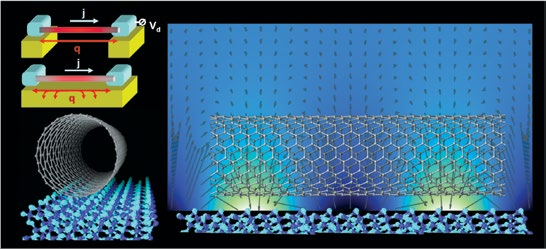Consumers expect regular improvements in information technology, says Slava V. Rotkin, but these advances often come with a cost.
Take the laptop. Its billions of semiconductor electronic circuits grow ever tinier while the instrument’s power and capacity increase. But heat generated by electric current can melt circuits and cause hardware to fail.
Rotkin and researchers at IBM’s T.J. Watson Research Center and the Ioffe Institute in St. Petersburg, Russia, have developed a way of cooling carbon nanotube electronics by utilizing nonconventional radiation in a “nearfield zone” just above the substrate on which the nanotubes rest.
The new method requires the substrate to be composed of a polar material like silicon-dioxide, says Rotkin, an associate professor of physics. It channels excess heat from the nanotubes into the substrate which, being much larger, can be more effectively cooled by the vents pushing cool air through laptops.
“Other methods of heat dissipation do not succeed in discharging heat from within the channel of the nanotube or nanowire,” says Rotkin. “Our method enables the heat to leave the channel and move to the substrate, while also scattering the hot electrons. This constitutes a novel cooling mechanism without any moving parts or cooling agents.”
Rotkin and his colleagues reported their results earlier this year in Nano Letters.
Because the nanotubes and substrate are made of heterogeneous materials, says Rotkin, their rate of thermal coupling, or heat release, is relatively low. This makes it difficult to dissipate heat from the nanotubes to the substrate through classical thermal conduction.
Rotkin and his colleagues instead utilize what they call surface phononpolariton (SPP) thermal coupling by exploiting the high level of electron scattering that occurs in nonsuspended carbon nanotube transistors.
A wave called a surface polariton is caused by this electron scattering, says Rotkin. This polariton is particularly strong in the near field zone just above the substrate on which the carbon nanotubes rest.
“If you put a layer of carbon nanotubes in a near field zone,” says Rotkin, “this enables the hot electrons to be scattered by the surface polariton and to give out energy to the substrate. Heat is dissipated into the substrate as radiation tunnels from the nanotube through the near field zone to the substrate.
“Most semiconductor devices fabricated now have the nanotube or nanowire placed directly on a silica substrate, which is polar. With this mechanism, if the substrate is polar and if there’s a small van der Waals gap, our new near-field channel totally dominates thermal coupling.”
Rotkin is a primary faculty member in Lehigh’s Center for Advanced Materials and Nanotechnology.

